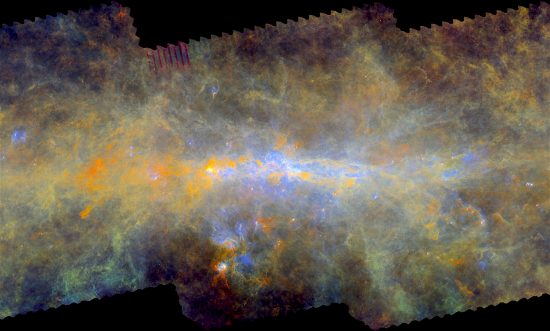
The center of the Milky Way from the Herschel Space Observatory. Composite image of 70 microns (blue), 160 microns (green) and 350 microns (red). Credit: ESA/Herschel/PACS, SPIRE/Hi-GAL Project. Acknowledgement: G. Li Causi, IAPS/INAF, Italy
Feb 20, 2017
A curled torus is thought to exist in the center of the Milky Way.
“Ring out the false, ring in the true.”
— Alfred Lord Tennyson
A previous Picture of the Day discussed the twisted ring of material surrounding the nucleus of Galaxy Centaurus A. NGC 5128, is an “active galaxy” that exhibits characteristic axial jets and a transverse, donut-shaped plasma discharge. An active galaxy is much brighter than other galaxies of the same type. They emit most of their excess energy from a compact galactic nucleus.
According to observations conducted by the now defunct Herschel Space Observatory, the Milky Way is also home to a twisted toroid of plasmas orbiting the galactic center.
Some astronomers suggest that the ring might exist because of a “standing wave” in the central bulge. Such a wave, in their eyes, is caused by spin and inertia: combining those forces is thought to create a gravitationally unstable region that initiates an unusual oscillation in the “gas and dust” that is held there by gravity.
Consensus opinions state that galaxies spin because of how they form. A hypothetical cloud of gas and dust contracts, causing its spin rate to increase. Spiral arms form, a disk of material surrounds the central nucleus, and gravitational eddy-currents inside the disk condense into stars.
The spinning cloud is supposed to overcome its internal gravitational attraction with centrifugal force, flinging out material like drops of paint on a rotating disk. How a randomly moving cloud of particles acquires a net spin is unexplained by consensus astronomers.
In an Electric Universe, galaxies are created within helical electric currents that form a great circuit through intergalactic space. The Bennett pinch effect squeezes plasma inside these cosmic “transmission lines” compressing vast clouds of ionized plasmas within electromagnetic fields, igniting stars and forming toroidal currents around galactic equators.
Hannes Alfvén’s “electric galaxy” hypothesis states that galaxies are more like a device invented by Michael Faraday, the homopolar motor/generator. A homopolar motor is driven by magnetic fields induced in a circular, conductive metal plate. The plate rotates between the poles of an electromagnet, causing it to spin at a rate proportional to the input current.
Since galaxies are part of a filamentary circuit that flows through the cosmos, they most likely spin because of electricity flowing through them like it does through Faraday’s motor. Galaxies exist within an inconceivably large filamentary circuit of electricity. There is no way to know where this charge flow rises, or to what electrode it is attracted, but we see the effects of its electromagnetic fields in the magnetism and synchrotron radiation that permeate space.
Electricity organizes itself within fields of plasma that are sometimes larger than galaxy clusters. The plasma is composed of neutral atoms, but a small percentage of charged particles are also present. Those particles, and the charge-neutral ones they sweep along with them, are driven by the larger electromagnetic field, creating “pinches” of matter.
Rather than a gravitational impetus from cold gas, it is electromagnetic plasma that is spinning the Milky Way’s center, forming the ring.
Stephen Smith












